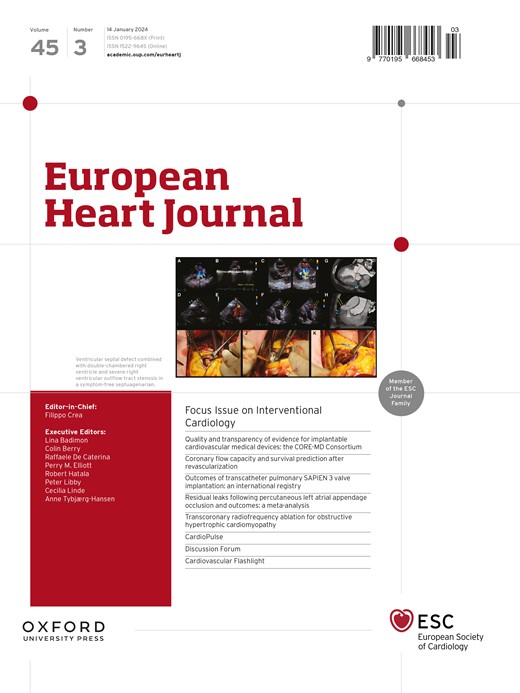经皮冠状动脉介入治疗后双重抗血小板治疗降压策略的性别差异:网络荟萃分析
IF 37.6
1区 医学
Q1 CARDIAC & CARDIOVASCULAR SYSTEMS
引用次数: 0
摘要
背景和目的与标准DAPT相比,双重抗血小板治疗(DAPT)降压策略可改善经皮冠状动脉介入治疗(PCI)后的预后。然而,性别对这些策略的安全性和有效性的潜在影响尚未得到充分调查。方法纳入随机对照试验,比较无基线口服抗凝指征的患者降糖与标准DAPT方案,并按性别分层报告结果。共同主要终点是试验定义的主要不良心血管事件(MACE)和大出血。计算风险比(HR)和95%置信区间(CI),以解释不同的随访时间。网络荟萃分析包括治疗排序,探讨不同的DAPT降级策略在女性和男性之间的比较效果。结果共纳入20项试验的7272例患者,其中女性占23.3%。降压策略分为(1)停用DAPT,使用阿司匹林或P2Y12抑制剂;(2) P2Y12抑制剂切换或剂量减少。停用DAPT与标准DAPT相比,MACE (Pint = 0.028)和大出血(Pint = 0.015)的治疗效果与性别之间存在显著的相互作用。事实上,停用DAPT降低了女性的MACE (HR, 0.86;95% CI, 0.75-0.98),但男性没有(HR, 1.04;95% CI 0.93-1.16),而减少男性大出血(HR, 0.60;95% CI, 0.44-0.82),但女性没有(HR, 1.04;95% CI, 0.76-1.43),与标准DAPT相比。相反,与标准DAPT相比,P2Y12抑制剂切换或剂量减少对MACE (Pint = .668)和大出血(Pint = .858)均无性别相互作用。在治疗排名中,阿司匹林停药在大多数女性患者中效果最好,而P2Y12抑制剂改用氯吡格雷在男性患者中效果最好。结论:性别可能影响PCI术后抗血小板降级策略的安全性和有效性,特别是那些涉及缩短DAPT的策略。停用阿司匹林可能是女性的最佳策略,而P2Y12抑制剂改用氯吡格雷可能对男性最有效。本文章由计算机程序翻译,如有差异,请以英文原文为准。
Sex differences in dual antiplatelet therapy de-escalation strategies after percutaneous coronary intervention: a network meta-analysis
Background and Aims Dual antiplatelet therapy (DAPT) de-escalation strategies improve outcomes after percutaneous coronary intervention (PCI) compared to standard DAPT. However, the potential impact of sex on the safety and efficacy of these strategies is yet to be fully investigated. Methods Randomized controlled trials comparing de-escalated vs standard DAPT regimens in patients without baseline indication for oral anticoagulation reporting outcomes stratified by sex were included. The co-primary endpoints were trial-defined major adverse cardiovascular events (MACE) and major bleeding. Hazard ratios (HR) with 95% confidence intervals (CI) were computed to account for different follow-up durations. A network meta-analysis including ranking of treatments was performed to explore the comparative effects of different DAPT de-escalation strategies among females and males. Results Overall, 71 272 patients from 20 trials were included, and 23.3% were female. De-escalation strategies were grouped into (1) DAPT discontinuation, by aspirin or the P2Y12 inhibitor; or (2) P2Y12 inhibitor switch or dose reduction. With DAPT discontinuation vs standard DAPT, a significant interaction between treatment effect and sex was found for both MACE (Pint = .028) and major bleeding (Pint = .015). Indeed, DAPT discontinuation reduced MACE in females (HR, 0.86; 95% CI, 0.75–0.98) but not in males (HR, 1.04; 95% CI 0.93–1.16), while reducing major bleeding in males (HR, 0.60; 95% CI, 0.44–0.82) but not in females (HR, 1.04; 95% CI, 0.76–1.43), compared to standard DAPT. Conversely, no interactions by sex were found with P2Y12 inhibitor switch or dose reduction vs standard DAPT for both MACE (Pint = .668) and major bleeding (Pint = .858). At treatment ranking, aspirin discontinuation ranked best for most outcomes in females, while P2Y12 inhibitor switch to clopidogrel showed the best outcomes in males. Conclusions Sex may influence the safety and efficacy of antiplatelet de-escalation strategies after PCI, particularly those involving the shortening of DAPT. Aspirin discontinuation may represent the optimal strategy for females, while P2Y12 inhibitor switch to clopidogrel may be most effective for males.
求助全文
通过发布文献求助,成功后即可免费获取论文全文。
去求助
来源期刊

European Heart Journal
医学-心血管系统
CiteScore
39.30
自引率
6.90%
发文量
3942
审稿时长
1 months
期刊介绍:
The European Heart Journal is a renowned international journal that focuses on cardiovascular medicine. It is published weekly and is the official journal of the European Society of Cardiology. This peer-reviewed journal is committed to publishing high-quality clinical and scientific material pertaining to all aspects of cardiovascular medicine. It covers a diverse range of topics including research findings, technical evaluations, and reviews. Moreover, the journal serves as a platform for the exchange of information and discussions on various aspects of cardiovascular medicine, including educational matters.
In addition to original papers on cardiovascular medicine and surgery, the European Heart Journal also presents reviews, clinical perspectives, ESC Guidelines, and editorial articles that highlight recent advancements in cardiology. Additionally, the journal actively encourages readers to share their thoughts and opinions through correspondence.
 求助内容:
求助内容: 应助结果提醒方式:
应助结果提醒方式:


